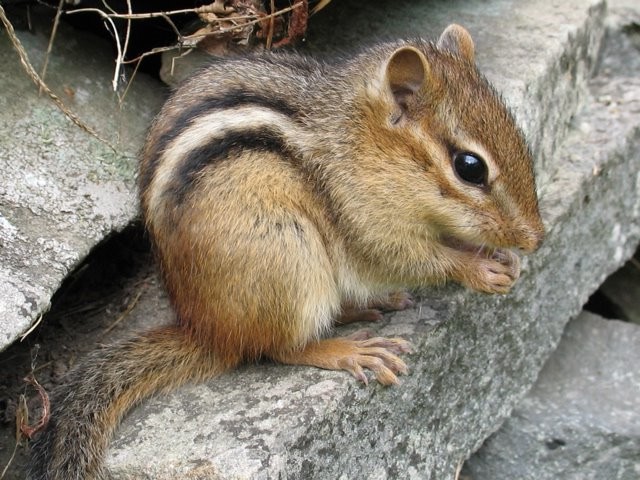

The mounds of dirt that squirrels excavate to build burrows in hay fields can damage haying equipment and take fields out of production. They compete with livestock for forage and can destroy food crops. High concentrations of Wyoming ground squirrels can pose a serious pest problem. Predators of the Wyoming ground squirrels include bullsnakes, rattlesnakes, coyotes, foxes, badgers, weasels, bobcats and raptors. Density of Wyoming ground squirrel populations can range from two squirrels per acre before young are born in the spring, to 20 or more animals per acre in early June when juveniles and adults are active. The young are weaned at five weeks and are foraging above ground by June. The young are born after a three- to fourweek gestation period with two to 10 young per litter. Breeding takes place one to four days after females emerge from hibernation. Males usually come above ground one to three weeks before the females. The squirrels enter their burrows in late July or early August and hibernate until the following March or April. The burrow is the center of a ground squirrel’s activity.

Squirrels stay in their burrows at night and during the warmest part of summer days. In brushy country, Wyoming ground squirrel burrows often are identified by a substantial pile of debris (sticks, rocks, sagebrush leaves) that covers the area downslope from the burrow entrance. Wyoming ground squirrels construct and live in underground burrows. They also eat insects, including grasshoppers, crickets and caterpillars, and eggs from ground-nesting birds. When green vegetation becomes scarce, the squirrels eat dry grasses and seeds. Wyoming ground squirrels prefer green foliage, such as grasses, but also eat forbs and shrubs. When walking through suspected plague areas, apply an insect repellent to socks and pant cuffs before tucking pants inside boots. Early diagnosis and treatment is imperative. Early symptoms of plague include swollen and tender lymph nodes, chills and fever. Plague is transmitted to humans via flea bites.

Ground squirrels are hosts for fleas and may act as carriers for bubonic plague. This has garnered them the nickname of “high mountain prairie dogs,” because they can tolerate high elevations and will flourish if predators are absent. It prefers open sagebrush, grasslands and subalpine meadows. The species occupies areas from 5,000 feet to above timberline in the north central and northwestern sections of Colorado. Wyoming ground squirrels are found in Colorado, southern Wyoming, western Nebraska and Utah. Wyoming ground squirrels have an underground burrow without the larger mounds, and most often what one sees is the ground squirrel darting into the hole for safety during the morning hours. The animals are not nearly as large as prairie dogs but are sometimes mistaken as such. Figure 1: Wyoming ground squirrel distribution*** Its fur is generally a brownish smoke-gray, with a dappled pattern of cinnamon-buff. Formerly called “Richardson’s ground squirrel,” the Wyoming ground squirrel averages 10 to 15 inches long and weighs 9 to 14 ounces as an adult.

The Wyoming ground squirrel ( Urocitellus elegans formerly Spermophilus elegans) is one of six species of ground squirrels found in Colorado.


 0 kommentar(er)
0 kommentar(er)
